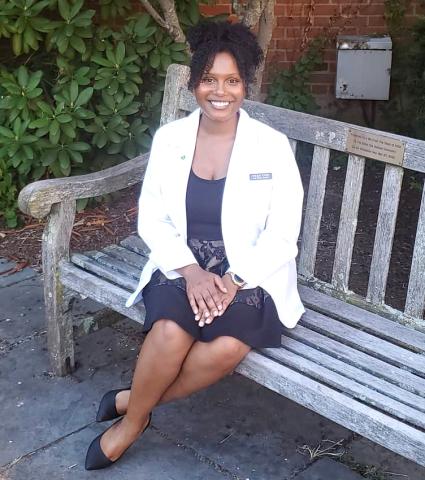Former IRTA Fearce Pursues Career Goals with Perseverance

Chelesa Fearce’s ultimate goal is to become an academic physician—practicing medicine and conducting research. That goal may not seem unique for someone who spent the past 2 years in the NIH postbaccalaureate Intramural Research Training Award (IRTA) program. However, Fearce—who recently started her first year at Yale University School of Medicine—is herself unique. And, it’s not her career goals that make her so. Her sheer determination and perseverance in accomplishing those goals set her apart.
At age 24, Fearce has already had to overcome a lifetime of adversity. When she was 9 years old and in the fourth grade, her mom was diagnosed with cancer. With her mom unable to work and medical expenses accumulating, the family (which includes Fearce, her mom and three siblings) became homeless—often moving from shelter to shelter and even living in their car and sometimes in hotels. But Fearce never lost focus on her education.
“I used my little brother and sister as motivation,” she said. “I wanted to be a good role model for them. I wanted them to know that despite what we were going through, they could accomplish whatever they set their minds to. I leaned on my religion a lot. I truly believe that there is a purpose for everything that we go through.”
Fearce developed her love for science as a freshman in high school. She was heavily influenced by her African-American science teachers. “Seeing them really helped me see myself as someone who could do science in the future,” she said.
Fearce excelled in high school, finished at the top of her class and was valedictorian at Charles Drew High School’s graduation in Riverdale, Ga., in 2013.
She earned a full scholarship to Spelman College in Atlanta. While there, Fearce discovered an interest in research. She conducted computational and physical chemistry research, studying how molecules were formed using free radical mechanisms on the pre-biotic Earth. She also had an undergraduate summer research experience at the University of Cincinnati, where she helped identify compounds as tanning agents for the treatment of melanoma. She graduated from Spelman in May 2017 with a bachelor of science degree in biochemistry.
In June 2017, Fearce entered NIH’s IRTA program, working in the laboratory of Dr. David Sibley in the molecular neuropharmacology section of NINDS’s Division of Intramural Research. Her work involved studying the behavior of dopamine receptors and screening drugs for their ability to influence the receptors’ activity. The goal was to discover compounds that could be used to treat schizophrenia. Fearce completed the program in May 2019.
“My lab was very supportive and really helped solidify my decision to pursue the dual degree,” she said. “The other postbacs were most memorable; they made my time at NIH worthwhile. My mentors, Dr. Sibley and Dr. R. Benjamin Free, took a chance on me and I appreciate them giving me the opportunity to join their lab.”
This fall, Fearce began the next leg of her career as an M.D./Ph.D. candidate at Yale University School of Medicine, where she intends to join the pharmacology or chemistry Ph.D. program.
“The future is brighter,” said Fearce. “I know that it is easy to want to give up, but I encourage other individuals facing homelessness to realize that they too can be an inspiration to future individuals and that this experience will only make them stronger.”
